End of tenancy notice letter template
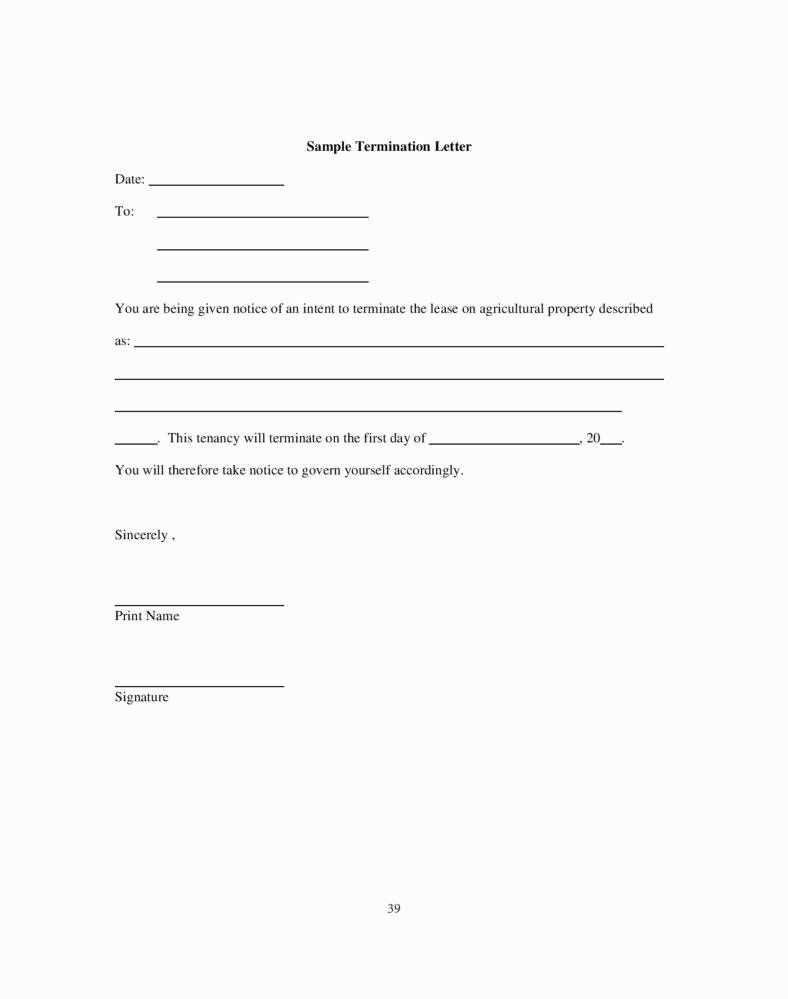
Write a clear and concise notice when ending your tenancy. A proper notice helps ensure a smooth transition and avoids misunderstandings. Make sure to include key details such as your name, the landlord’s name, the address of the rental property, and the intended date of vacating.
Specify the date you will be leaving and refer to any agreements or laws governing the notice period. Be polite and professional while keeping the tone direct and to the point. It’s also advisable to state your intention to return the property in good condition and inquire about the return of your deposit.
By being transparent and organized, you ensure both parties understand the expectations and responsibilities, leading to a hassle-free conclusion of the tenancy. Use the following template as a guide when drafting your letter.
Here’s the corrected version:
To craft a clear and direct end of tenancy notice, ensure that it includes the following key details:
| Element | Description |
|---|---|
| Recipient | The letter should be addressed to the landlord or property management company. |
| Notice Date | State the date when the notice is being written. |
| Tenancy End Date | Clearly mention the date when the tenancy will end. |
| Address | Provide the address of the rental property. |
| Reason (Optional) | You may include the reason for ending the tenancy if desired. |
| Contact Information | Provide your contact details for follow-up purposes. |
This format helps ensure all important details are covered, allowing both parties to prepare for the end of the lease smoothly.
- End of Tenancy Notice Letter Template
Write a clear, concise letter when ending a tenancy. Below is a straightforward template to help you draft your notice. Make sure to personalize the details as needed.
Template
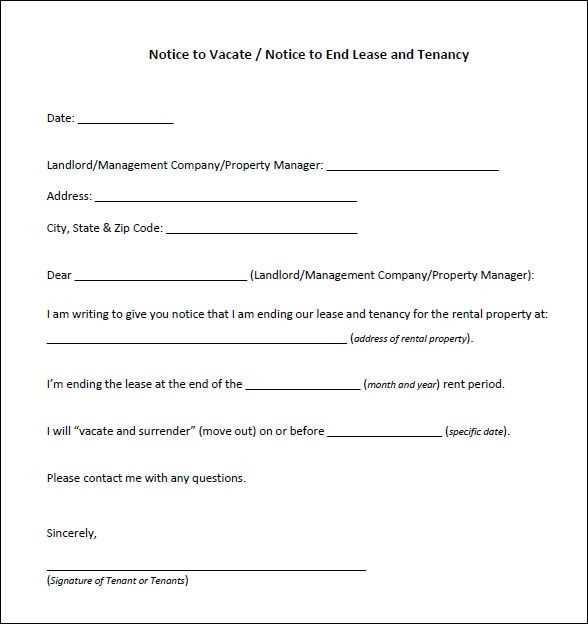
Dear [Landlord’s Name],
I am writing to formally notify you that I am terminating the tenancy for the property at [Your Address] as of [Date]. In accordance with the terms of the rental agreement, this letter serves as my [Notice Period] notice.
I will ensure that the property is in good condition and return the keys by [Date]. Please let me know if there is any further information or action required on my part before my departure.
Thank you for the opportunity to rent the property. I look forward to your prompt response regarding the return of my security deposit.
Sincerely,
[Your Name]
Key Points
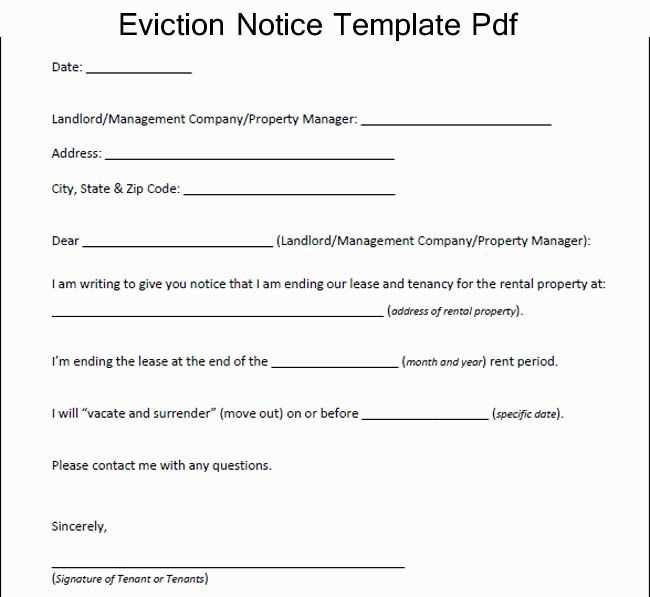
- Clearly state the termination date.
- Include your notice period as per the rental agreement.
- Offer to return keys and clarify the condition of the property.
- Request details about the return of your security deposit.
Start your notice with a clear statement of intent. Address your landlord directly, mentioning your full name, the property address, and your rental agreement details. Ensure the notice is professional and includes all required information.
Key Information to Include
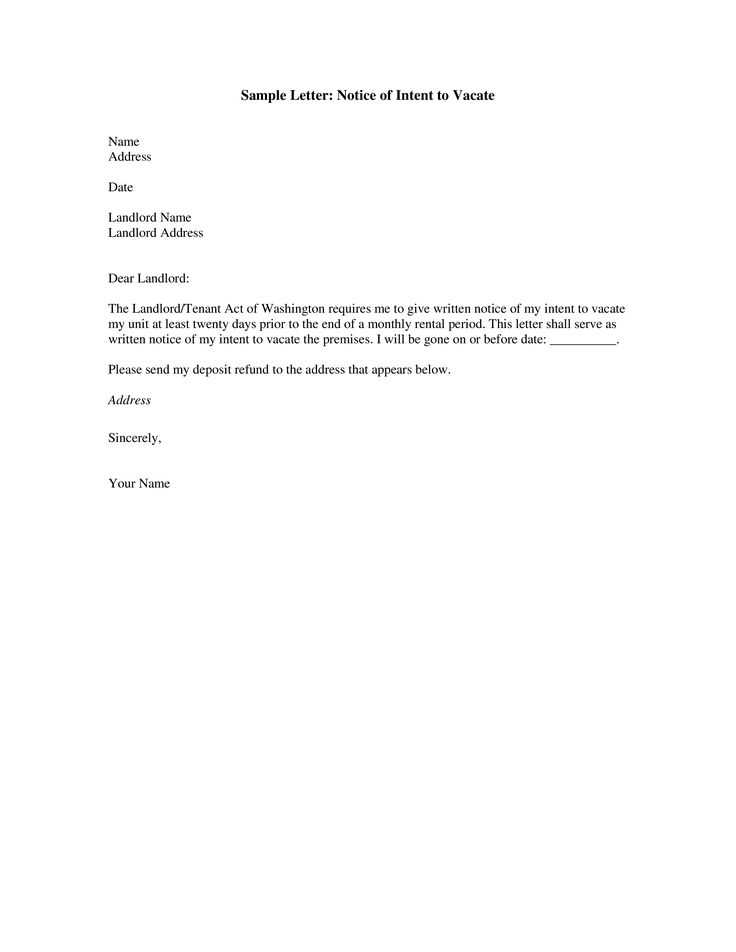
Include the following details right at the beginning:
| Detail | Description |
|---|---|
| Tenant Name | State your full legal name as per the lease agreement. |
| Property Address | Clearly state the rental property’s full address. |
| Notice Date | Specify the date the notice is being written. |
| End of Tenancy Date | State the date you wish to vacate the property, ensuring it aligns with the notice period stipulated in the agreement. |
Sample Beginning of Notice
Here’s an example:
“Dear [Landlord’s Name],
I am writing to inform you that I will be ending my tenancy at [Property Address], as per the terms of our rental agreement. My last day of tenancy will be [Date].”
Start by clearly stating the tenant’s full name, the property address, and the date of the letter. These details help identify the parties involved and ensure there is no ambiguity about the rental property in question.
Notice Period and Move-Out Date
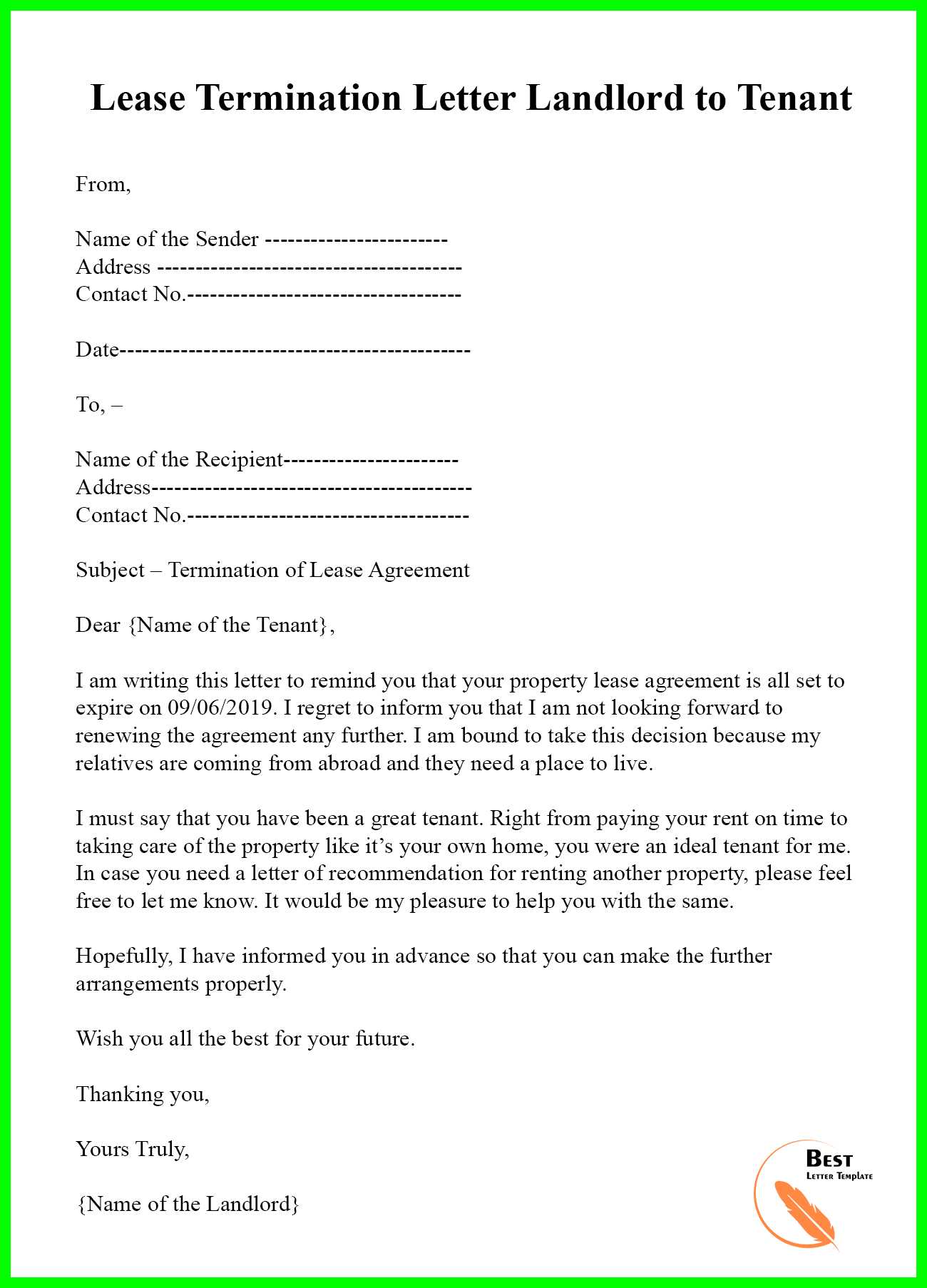
Specify the date when the notice is being issued, along with the date by which the tenant intends to vacate. This helps to establish a timeline and ensures both parties are aligned on the expectations for the end of the tenancy.
Reason for Leaving (Optional)
While not mandatory, providing a reason for vacating the property can help clarify the situation. It may be useful for the landlord to understand the context, but it’s not required in most cases.
Ensure that the notice reflects the terms of the lease agreement, including any required notice period. Double-check whether the lease specifies a minimum number of days that the tenant must give before leaving, and include this information in your letter.
Forwarding Address
Include the tenant’s forwarding address for the return of the security deposit. This allows the landlord to send any remaining funds or important documents to the correct location.
Conclude the letter with a polite closing statement, such as thanking the landlord for their understanding and cooperation. Always sign the letter to make it official.
Ensure the notice is clear and easy to follow by following a logical structure. Start with the tenant’s details and the landlord’s contact information at the top. Clearly state the purpose of the letter–giving notice for ending the tenancy. Include the effective date of the termination, specifying the last date of occupancy.
Details to Include
Start with your full name and address at the top left corner of the letter. Then, provide the landlord’s or property manager’s name and address. This establishes clear communication. Follow up with the subject line: “Notice of Termination of Tenancy” or a similar, straightforward title.
Clear and Direct Language
The body of the letter should remain concise. State the notice period in accordance with the rental agreement or legal requirements. Avoid unnecessary wording. For example: “I am giving notice of my intent to vacate the premises at [address] by [date], as per our agreement.” End with a polite closing line, such as “Thank you for your cooperation.” Sign the letter with your full name at the bottom.
Failing to include the correct notice period can lead to complications. Ensure you clearly state the date the notice is being given and when the tenancy ends.
1. Incorrect Dates
Double-check the dates you list. An error here can invalidate your notice and create misunderstandings. Make sure the start date of the notice aligns with your lease agreement.
2. Lack of Signature
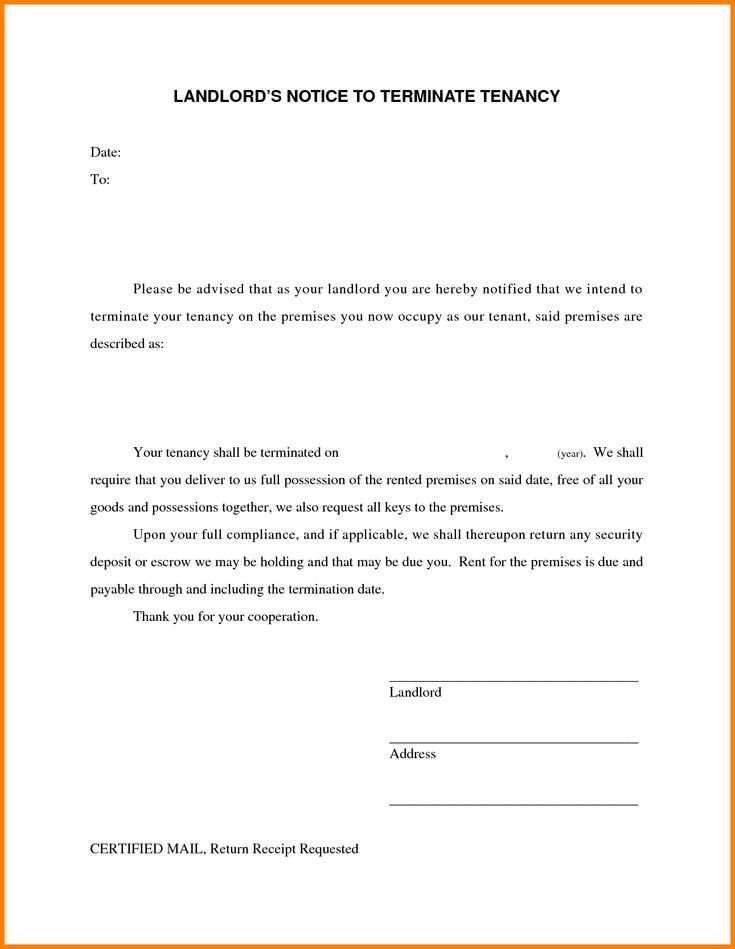
Leaving the letter unsigned can cause delays. Always sign the notice before sending it to confirm that it’s officially from you.
3. Missing Tenant’s or Landlord’s Details
Ensure both parties’ names and contact information are clearly stated. This avoids any confusion about who is issuing the notice.
4. Vague Language
Avoid ambiguous terms that could be misinterpreted. Be as clear and specific as possible about the termination date and terms.
5. Not Following the Lease Agreement
- Review your lease for specific clauses about giving notice.
- Ensure you follow any outlined procedures for sending the notice, such as using certified mail.
6. Incomplete Address Information
Check that you’ve included the correct address for both yourself and the landlord. An incomplete address can lead to missed communications.
7. Not Keeping a Copy
Keep a copy of the notice for your records. This helps resolve disputes if they arise later on.
After sending the notice, ensure that you keep a copy of it for your records. It is also advisable to track any communication with the landlord or property management regarding your notice. Stay prepared for a potential inspection, as the landlord may want to assess the condition of the property before your departure.
Make a list of any repairs or cleaning tasks that need to be completed. You may want to restore the property to its original state to avoid any deductions from your deposit. Schedule these tasks ahead of time to give yourself plenty of time before the move-out date.
Confirm the details of your move-out date with the landlord to avoid any confusion. Verify when the final inspection will take place and if there are any specific requirements for handing over the keys. This helps ensure that the transition goes smoothly and prevents any last-minute issues.
Use the following templates tailored for different scenarios when giving notice to end a tenancy.
- Standard End of Tenancy Notice
- Early Termination of Lease
- Notice Due to Rent Increase
Dear [Landlord’s Name],
I am writing to inform you that I will be vacating the property at [Address] on [Date]. As per the terms of the lease, I am providing [Notice Period] notice. Please let me know if you require any further information.
Thank you for your understanding.
Dear [Landlord’s Name],
I regret to inform you that due to unforeseen circumstances, I must terminate my lease early. I will vacate the property at [Address] on [Date]. I understand this may cause inconvenience, and I am willing to cooperate in finding a replacement tenant if necessary. Please let me know how you would like to proceed.
Thank you for your time and consideration.
Dear [Landlord’s Name],
As a result of the recent rent increase notice, I have decided not to renew my tenancy. I will be vacating the property at [Address] on [Date]. I appreciate your understanding and would be happy to assist with the transition.
Best regards,
Choose the template that best suits your situation and customize it to fit your needs. Be clear and respectful, ensuring smooth communication with your landlord.
Ensure your end of tenancy notice includes these key elements for clarity and legal protection:
- Clear Intent to Leave: State your intention to vacate the property, including the specific date of departure.
- Proper Notice Period: Adhere to the notice period specified in your lease agreement, typically 30 days.
- Contact Information: Provide a current address or email for follow-up communications.
- Address the Landlord: Use the correct legal name and address of your landlord or property manager.
- Reason for Leaving (Optional): If you wish, include a brief reason for leaving, though it is not required.
Ensure the letter is signed and delivered in accordance with your lease terms for validity. Keep a copy of the notice for your records.